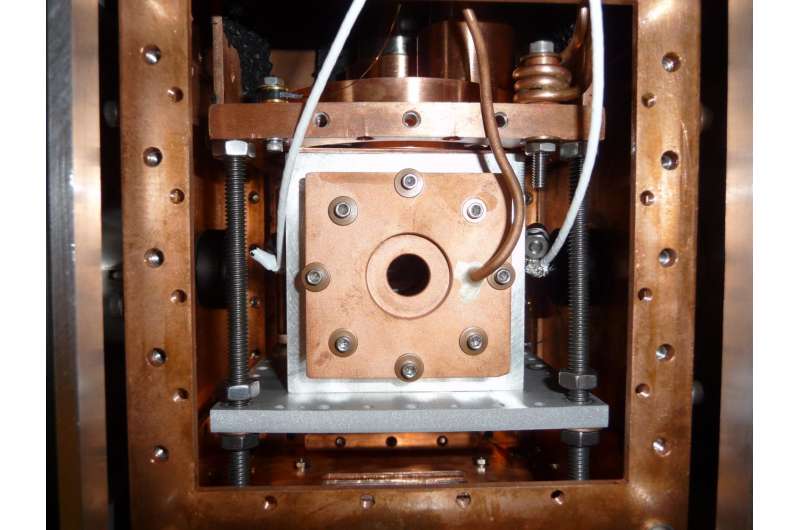JILA extends laser 'combing' method to identify large, complex molecules

JILA physicists have extended the capability of their powerful laser "combing" technique to identify the structures of large, complex molecules of the sort found in explosives, pharmaceuticals, fuels and the gases around stars.
The advance, described in a Nature paper published online May 4, 2016 was made possible by a cooling method developed by Harvard University researchers, who co-authored the study. The JILA-Harvard work boosts the might of spectroscopy, the studyof interactions between matter and light, which informs many fields, such as chemistry, physics, astronomy, imaging and remote sensing.
JILA is a partnership of the National Institute of Standards andTechnology (NIST) and the University of Colorado Boulder.
JILA's tabletop-sized apparatus is based on a laser frequency comb, a "ruler of light" recognized in the 2005 Nobel Prize in Physics. JILA researchers developed their original molecule-detection system a decade ago. Since then, they have demonstrated the technique for applications such as breath analysis to detect disease, identification of trace gases in the atmosphere, and detection of contaminants in semiconductors.
In the combing method, molecules are placed in a hollow chamber, or cavity, in which the comb laser light bounces back and forth. A small fraction of the comb light is absorbed at specific frequencies at which the molecules rotate and vibrate. Each molecule's unique "fingerprint" is identified in the absorption patterns across the thousands of comb frequencies. The method is sensitive and specific but, until now, has been limited to small, simple molecules made of fewer than 10 atoms. That's because even small molecules can exist in millions of rotation and vibration states, each with a different energy level, making their signals hard to pick out.
"Being able to detect and unambiguously identify large molecules has been a longstanding goal," JILA/NIST Fellow Jun Ye says. "First, it provides fundamental insights into molecular structure and dynamics. Second, it allows us to understand increasingly complex systems. Third, for applications ranging from breath analysis to explosives detection, the capability to detect large molecules has been missing."
Previously, the JILA system probed molecules at room temperature. The upgraded system incorporates Harvard's helium buffer gas cooling method. The buffer gas chills the molecules to only a few degrees above absolute zero (to about minus 265 °C or minus 445°F), drastically slowing their speed and rotation. This simplifies and strengthens absorption signals and greatly boosts the ability to identify the molecules. In addition, the buffer gas system allows the molecules to be probed for more than 10 milliseconds, a thousand times longer than other cold molecule research systems, which may enable the tracking of cold chemical reactions.
"Instead of just a glob of mountains in the signals, you can actually start to see the individual trees," Ye says.
By probing many frequencies at once, the combing method is a thousand times more efficient than traditional single-frequency laser spectroscopy that records absorption signals one frequency at a time. The comb's precision also makes the JILA method more accurate and sensitive than conventional broadband spectroscopy using white-light sources.
The JILA team demonstrated their enhanced system by identifying organic compounds with carbon-hydrogen bonds that can vibrate and rotate in multiple ways, such as by stretching, scissoring, rocking, wagging and twisting. The team detected the first high-resolution absorption patterns of multiple vibrations of carbon-hydrogen bonds in four complex molecules—and did so quickly, in just 30 minutes to several hours:
- nitromethane (7 atoms, a model system for studies of complex internal vibrations), used in making pharmaceuticals, explosives and fuels;
- naphthalene (18 atoms), used in mothballs and detected in interstellar space;
- adamantane (26 atoms), derivatives of which are used in drugs and lubricants; and
- hexamethylenetetramine (22 atoms), which is of interest in astronomy and is used to make plastics, pharmaceuticals and explosives such as RDX.
Ye says the JILA instrument may help scientists finally probe and understand huge structures such as buckyballs, which are round molecules of 60 carbon atoms. In addition, the method may enable studies of new molecular species and real-time chemical reactions, tracking the behavior of highly reactive "free radicals" such as those in explosives and human breath.
More information: Ben Spaun et al, Continuous probing of cold complex molecules with infrared frequency comb spectroscopy, Nature (2016). DOI: 10.1038/nature17440
Journal information: Nature
Provided by National Institute of Standards and Technology



















